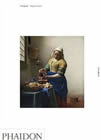Christ in the House of Martha and Mary
c. 1654–1656Oil on canvas
160 x 142 cm. (63 x 55 7/8 in.)
National Gallery of Scotland, Edinburgh
In Vermeer’s Christ in the House of Martha and Mary (fig. 1), Christ and Martha are placed in front of a wall, with the back of Christ’s chair apparently close to it. Although difficult to read and unconvincing in its effect, the lighter and darker segments of this wall probably indicate a sequence of two parallel walls joined by one receding at right angles. Otherwise, there would be virtually no room for Martha to stand behind the table. This pattern resembles the rear wall in Van Couwenbergh’s work which, however, is visually divided by a free-standing wooden post behind Christ’s left shoulder.
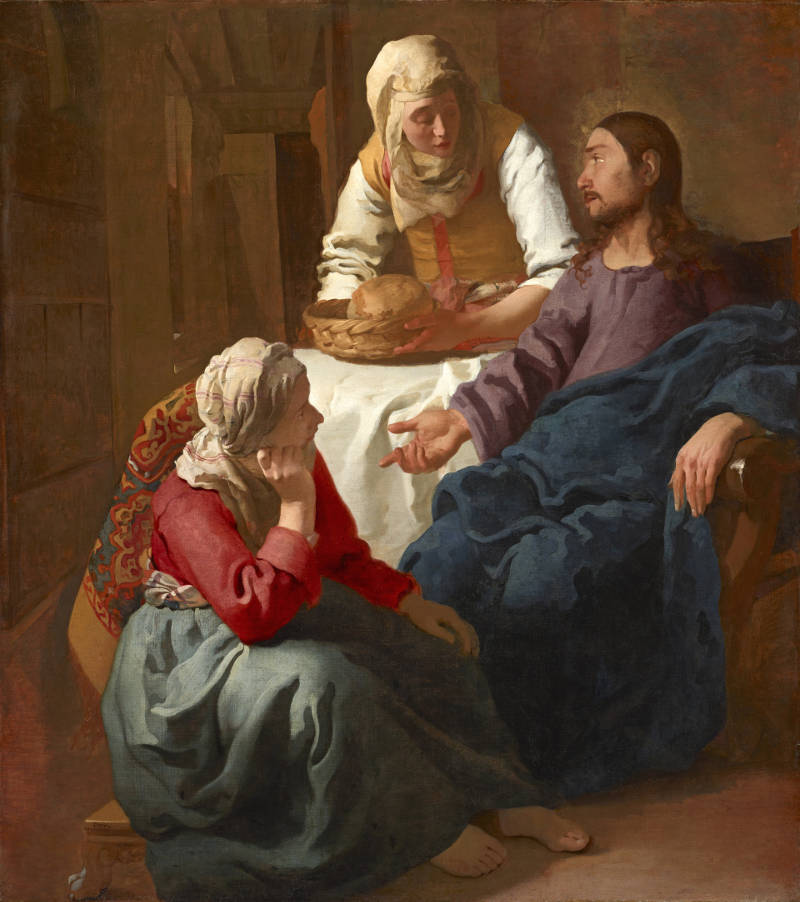 fig. 1 Christ in the House of Martha and Mary
fig. 1 Christ in the House of Martha and MaryJohannes Vermeer
c. 1654–1656
Oil on canvas, 160 x 142 cm.
National Gallery of Scotland, Edinburgh

Christiaen van Couwenbergh
1629
Oil on canvas, 121 x 147.5 cm.
Musée d’Arts de Nantes, Nantes
A recent X-radiograph of Vermeer’s painting…shows a light vertical line behind Martha’s left shoulder proper (parallel to the seam joining two pieces of canvas). Could this line have indicated a lit edge, possibly of a similar post or corner of the wall that Vermeer later painted out? The X-radiograph does not help to clarify the enigmatic structure of the narrow corridor on the left, which compositionally corresponds with the opening towards the kitchen in Christiaen van Couwenbergh’s painting (fig. 2).
In Vermeer’s picture, its far end is marked by a double door, with its right wing open. To the right of this door is an opening into another room or alcove from which an amorphous orange shape (a billowing curtain?) protrudes The left wall is pierced by two ambiguous openings. At the back is what appears to be a tall window, the top shutter open—or do the two small highlights underneath indicate steps leading to a door? Behind Mary, there is another puzzling structure, most likely a closed door or, possibly a recess in the wall, with integrated shelves. These uncertainties demonstrate Vermeer’s struggles to construct a convincing spatial continuum. It collapses entirely behind Mary’s stool, where the floor seamlessly continues into the wall. It is perhaps telling that after this unsatisfactory experience, Vermeer always chose simple, box-shaped spaces, usually showing just two walls and rarely including ceilings, and only twice—in A Maid Asleep and The Love Letter—allowed for a view into an adjacent room. The latter is the only other work to include a receding wall.
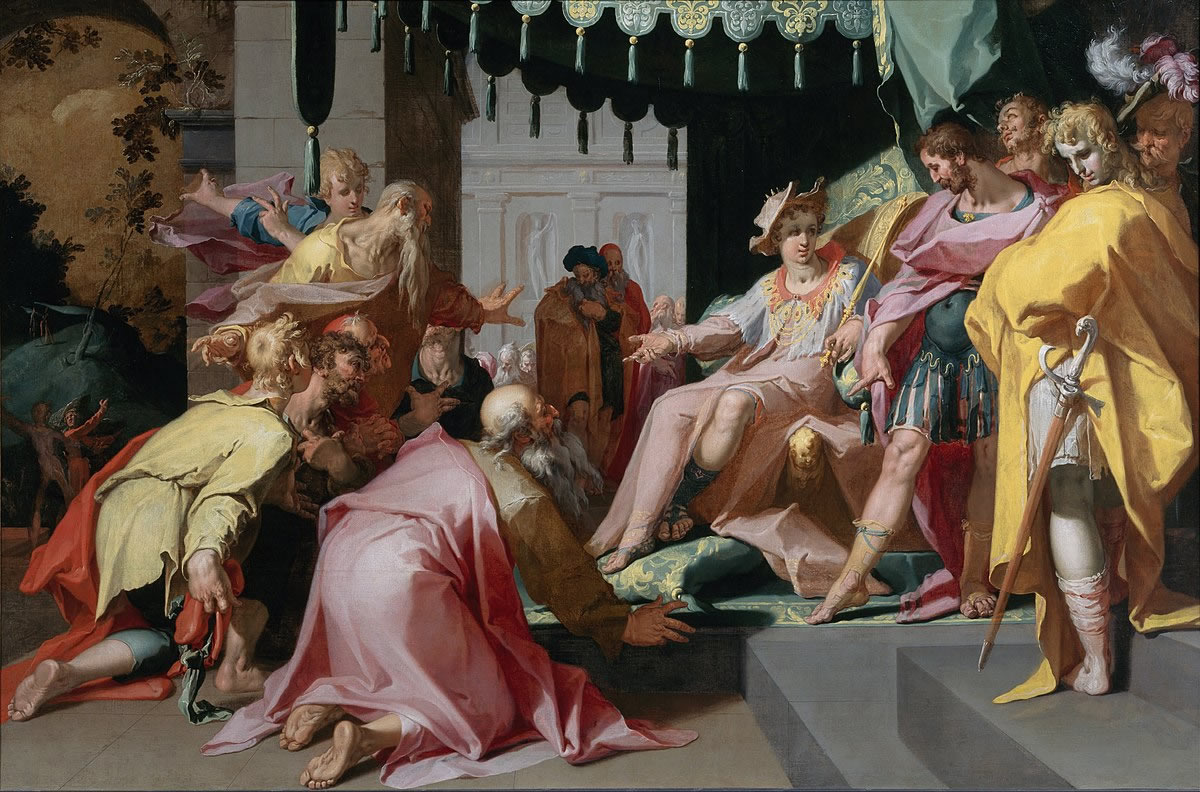
Abraham Bloemaert
c.1595–1600.
Oil on canvas 141.3 x 201 cm.
Centraal Museum, Utrecht
Christ in the House of Mary and Martha again reveals the sundry pictorial precedents that weighed most heavily upon Vermeer during his formative period. Scholars have most frequently called attention to the connections between this picture and works by painters from Utrecht and Flanders (modern-day Belgium; known as the Spanish Netherlands during the seventeenth century). For instance, the pyramidal arrangement of tightly compressed figures in the foreground, their firm modelling, and the striking combinations of colours are all reminiscent of the art of Hendrick ter Brugghen (1588–1629). Ter Brugghen was a prominent member of the so-called Utrecht Caravaggisti, a term denoting Dutch painters from the city of Utrecht who followed the Italian master Caravaggio. The faces of the women are in a style typical of ter Brugghen, particularly the seated Mary with her comely profile silhouetted against white linen (fig. 1).
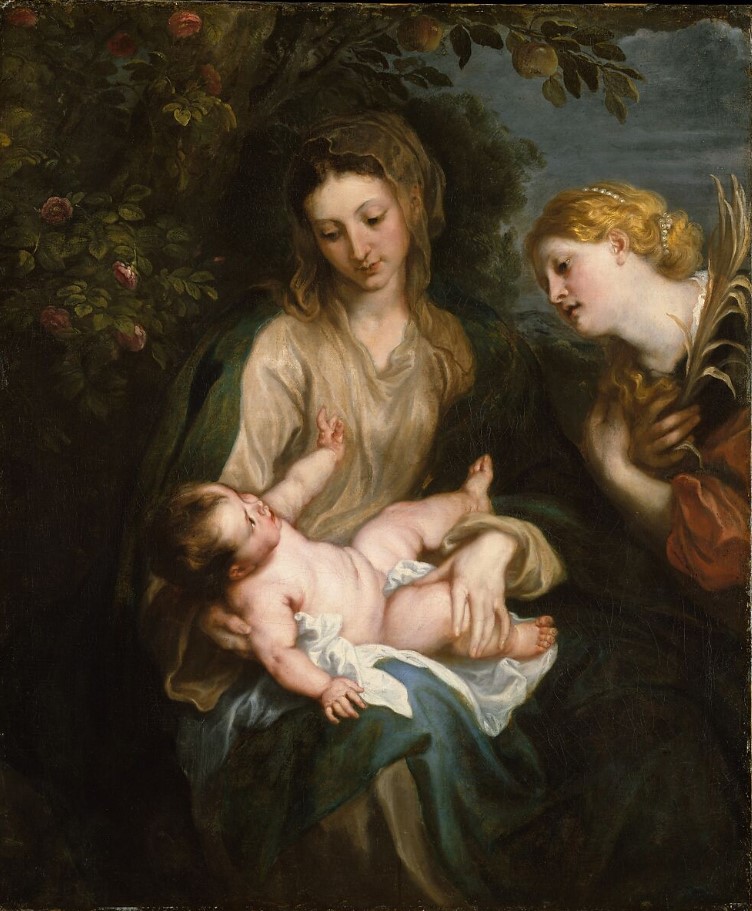
Anthondy van Dyck
Oil on canvas, 109.2 x 90.8 cm.
Metropolitan Museum of Art, New York
The pose of Christ has been associated with a variety of Flemish and even Italian prototypes; this pose was well established within the repertoire of painters from those countries by Vermeer’s day. Nevertheless, another possible connection, hitherto overlooked but potentially intriguing because it is much closer to home, can be seen in the seated figure of the Jewish patriarch Joseph in an important work by ter Brugghen’s teacher, Abraham Bloemaert (1566–1651) — Joseph with His Brothers, (fig. 3) from around 1595–1600. As mentioned this venerable Utrecht artist was a distant relative of Vermeer’s wife.
Walter Liedtke has identified some fascinating affinities between Vermeer’s fairly fluid brushwork in Christ in the House of Mary and Martha and the style of the renowned Flemish painter Anthony van Dyck (1599–1641). The descriptive highlights and rippled accents over broad areas of drapery in Vermeer’s canvas recalls, albeit in a schematic way, van Dyck’s own sophisticated painterly surfaces (fig. 4). Liedtke has also related the physiognomy of Vermeer’s handsome Christ, as well as his elegantly tapered hands, with the work of the Flemish artist. Even the tilt of Mary's head displays a van Dyckian air. Van Dyck, who enjoyed an international reputation as a portraitist, spent the winter of 1631–1 632 working at the Dutch court in The Hague.
In light of the close proximity of The Hague to Delft, Vermeer must have been familiar with his pictures. He could have also seen them (and those by Rubens) if he had travelled to Antwerp, which is entirely possible.
Paintings by truly talented artists are, however, rarely if ever, a mere compilation of motifs ‘borrowed’ or (more accurately) appropriated from other painters. The resultant work of art is always more than the simple sum of its parts. Vermeer subtly recasts the biblical tale and imparts to it a sensitive, poetic mood. His figures may recall van Dyck’s and ter Brugghen’s prototypes, but they remain distinctly his. Martha's partly illuminated face, for example, with her slightly parted lips and musing, downcast eyes, anticipates several females who populate his later genre paintings.
For those who know Vermeer through paintings like The Milkmaid or The Music Lesson, Christ in the House of Martha and Mary always comes as a surprise. This large painting of a Biblical subject, set in a dark interior, does not accord with the popular conception of Vermeer. Indeed, the style and subject matter of this painting are also difficult for Vermeer scholars to explain satisfactorily. Were it not for the distinctive signature on Mary's stool (fig. 5) one would wonder to whom it would be attributed.
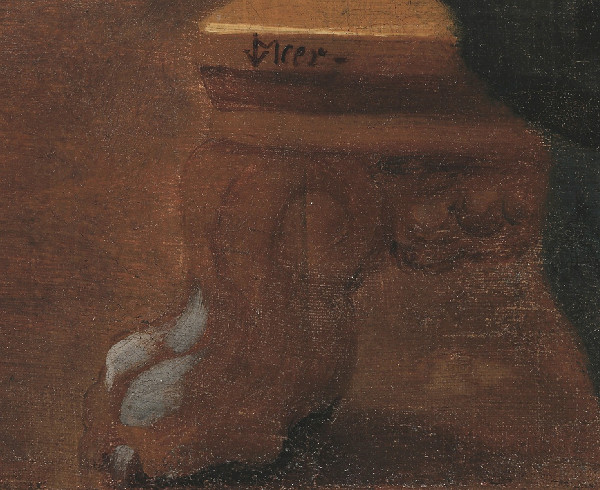
Johannes Vermeer
The subject of the painting is an incident that occurred while Christ was visiting the two sisters Martha and Mary. Martha complained that Mary, who was sitting listening to Christ's words, was not helping with the serving. Christ answered Martha's complaint by saying: "Martha, Martha, thou art careful and troubled about many things: But one thing is needful: and Mary hath chosen that good part, which shall not be taken away from her." (Luke 10: 41–42).
Christ in the House of Martha and Mary was a favorite theme for sixteenth-century artists like Pieter Larsen, who portrayed religious subjects in the backgrounds of kitchen scenes. This tradition continued into the seventeenth century, particularly in Flanders. Erasmus Quellinus, for example, painted this subject (fig. 6) around 1650 in collaboration with the still life artist Adrian van Utrecht. Although their work retained elements of the sixteenth-century kitchen paintings, Quellinus's figure of Christ anticipates that in Vermeer's work. Vermeer's representation of the theme differs from this tradition in that he focused totally on the three figures. Christ, because of his gesture and the soft glow that radiates from his head, is the dominant figure. Martha leans over to hear his words while Mary sits by his feet, her head resting on her hand. The close bonds among them are strengthened because the background, including the stairway on the left and the room in the background, is so cursively indicated.
This subject was more popular among Flemish artists than Dutch, possibly because of the religious connotations of the story. Martha and Mary represented two opposing personalities: the active and the contemplative. Christ's defense of the contemplative life suited Jesuit ideals and actually was contained within the Spiritual Exercises of Ignatius of Loyola. Vermeer's treatment of this subject, which focuses on the message that Christ is transmitting, may reflect his sympathetic response to the Catholic Church in the mid-1650s. The motivation for painting this work, however, is difficult to determine. Vermeer may have been trained as a history painter by Bramer, but it is hazardous to assume that he painted this work from his own inspiration. A painting this large may well have been commissioned.
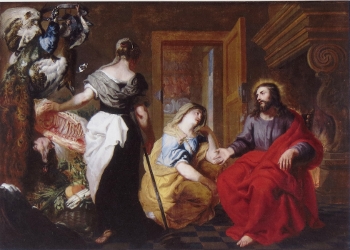
Erasmus Quellinus
c. 1645
Oil on canvas, 173 x 243 cm.
Musée des Beaux Arts, Valenciennes
Christ in the House of Martha and Mary is thought to be the earliest known painting by Vermeer. The strongest argument for its early date is the differences in painting techniques between this work and his later ones. In no other painting does he focus so exclusively on the figures in the central core of the composition. Vermeer in his mature works was very conscious of the relationship of his figures to their environment, a concern not evident in this work. Another element of Vermeer's mature style is his interest in rendering the specific textures of objects. The breadbasket in The Milkmaid of about 1658–1660, for example, is painted with careful attention to the character of the material and the construction of the basket (fig. 7) In comparison, the basket held by Martha is only scantily indicated (fig. 8). This superficial rendering of objects is also seen in the clothes of the figures. Folds are indicated with free-flowing brushstrokes, but ones which do not convincingly suggest the volume of the material.
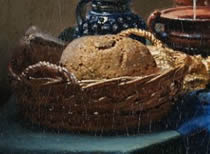
Johannes Vermeer
c. 1658–1661
Oil on canvas, 45.5 x 41 cm.
Rijksmuseum, Amsterdam

Johannes Vermeer
c. 1654–1656
Oil on canvas, 160 x 142 cm.
National Gallery of Scotland, Edinburgh
Given the superficial quality of the modeling, nevertheless senses in this work an artist who had already achieved a masterful technique of painting. The brushstrokes are certain. The interplay between opaque paints and semi-transparent ones in the shadows is effective. The conception of the scene, particularly in the way an iconographical type is transformed into an intimate confrontation of three figures, also is sophisticated.
Evidence about the nature of Vermeer's training is unfortunately difficult to determine from this work. The broad, smooth forms and triangular composition of Christ in the House of Martha and Mary indicate classicizing tendencies unrelated to the style of Bramer's small panel paintings. Bramer, however, also executed mural paintings that were similar in character to paintings by the Utrecht Caravaggisti with whom he worked. Thus, connections with Bramer, either directly or through his contacts with other artists, may help explain the derivation of the style of this painting.
Many attempts have been made to identify the specific source for the pose of Christ. It was, however, a standard rhetorical pose used by a number of Italian, Flemish, and Dutch artists, including Bramer, Quellinus and Jan Steen in his Christ in the House of Martha and Mary (fig. 9). One must assume that Vermeer, whose father had been an art dealer and who seems to have inherited his father's business, would have had opportunities to see this particular gesture in other paintings and prints.
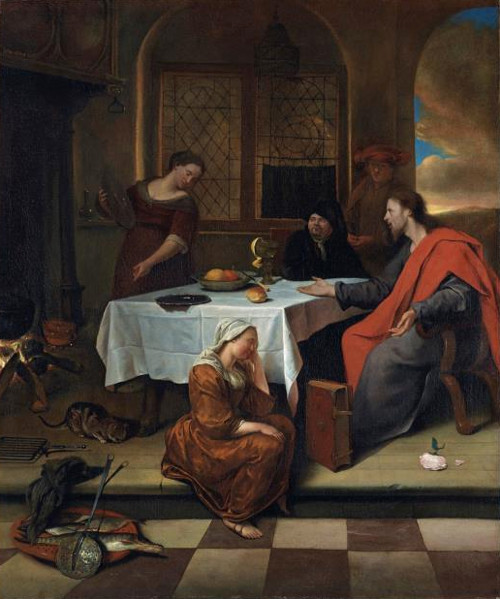
Jan Steen
Oil on canvas, 106 x 89 cm.
Private collection, Nimega

Walter Liedtke
"Vermeer Teaching Himself."The Cambridge Companion to Vermeer (Cambridge Companions to the History of Art)
2001, pp. 33–34
Christ in the House of Mary and Martha, when viewed in the original, is clearly a far more accomplished work of art (than Diana and her Companions). The kind of historical logic that has Vermeer proceeding from foreign to domestic, from painterly to precise, and from rhetorical to evocative cannot overrule the objection that this painting is more mature. This is not plain in reproduction, where the picture's space looks disjunctive and the areas of color reflect and go flat. In the actual object the sense of space is striking, especially on the left where the downward view of Mary foils the rapid recession of the corridor. That deeper space is introduced by the open door on the left and by the wall to the right, where Martha casts a shadow and a rectangular object to the right of her head defines the receding plane. Mary's stool, with the highlight just above Vermeer's signature, and the arm of Christ's chair thrust the space forward without making it clear in plan (the changed window ledge and the open door in the corridor are signs of struggle in Vermeer's earliest known application of linear perspective). But the emphatic modeling of the figures, which is drastically reduced in photographs, makes the close view, the sense of volume, and the space intensely felt at a normal viewing distance. The drapery throughout is beautifully painted, with thick, fluid highlights contrasting to the deep, absorbent shadows in the folds. A superb passage is the colorful carpet, which adds greatly to the visual weight of Mary; the pattern continues in her scarf, like bass and treble lines of music, and blends effortlessly into the sash at her waist. The rhythms throughout Mary's drapery lend emphasis to the focus on Christ, whose gesture and voice seem to animate his robe and sleeve and the cascading folds in the white tablecloth. Martha leans well forward, the space under her forearm and the basket (which casts a strong shadow) suggesting the tabletop's rapid recession to her. She seems to serve and bow at once, her lovely face demurely responding to Christ's rebuke. His profile was modified by Vermeer to more obliquely turn the head. All three faces, but especially Mary's, recall the evocatively toned and shaded faces in Ter Brugghen's oeuvre (fig. 10).
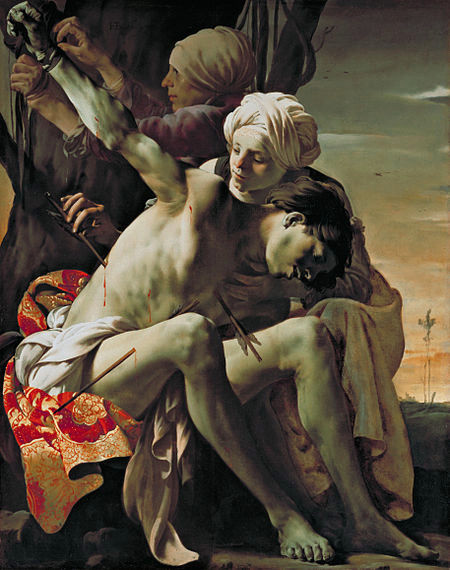
Hendrick ter Brugghen
1625
Oil on canvas, 149 x 119.4 cm.
Allen Memorial Art Museum, Oberlin College (OH)
It is a measure of Vermeer's progress in this painting that while its formal qualities are skillfully resolved, the subject is effectively realized. The interplay between the three figures never comes to rest: Christ seems to speak to Mary, and she reflects on his words, even as he answers Martha's complaint. The general design of the painting, even the setting's subordinate treatment in tones of brown, is Flemish, Van Dyck-like, and of course reminiscent of the often cited picture of the same subject by the contemporary follower of Rubens and Van Dyck, Erasmus Quellinus the Younger (1607–1678). Anyone who has seen that large canvas in Valenciennes will realize that its manner of execution could have been of no more than superficial interest to Vermeer. However, Christ's pose and the recession from him to a room in the background, beyond Mary, suggest that this or some version of the painting was known to the Delft artist. The background view in Vermeer anticipates that in A Woman Asleep at a Table, and in its more complex perspective and greater sense of depth already, seems like a Dutch painter's revision of the Flemish master's motif.
Christ in the House of Mary and Martha marks such an advance beyond Diana and Her Companions that one imagines them separated by more than a year within the period 1654–1655. There is no space here to discuss the controversial copy after Ficherelli's Saint Praxedis, which appears to be signed by Vermeer and dated 1655. Direct comparisons with Diana and Her Companions and Christ in the House of Mary and Martha must be made to support the attribution, but the brushwork in Saint Praxedis recalls both pictures (the later work) and, to a lesser extent, that of the Florentine painter himself. Saint Praxedis's face (fig. 11) and pose could have inspired the figure of Martha (fig. 12).
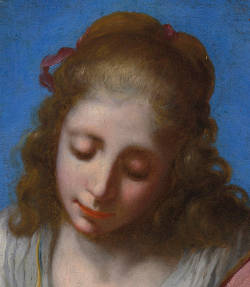
Johannes Vermeer
c. 1653–1656
Oil on canvas, 98.5 x 105 cm.
Mauritshuis, The Hague
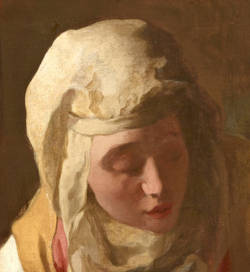
Johannes Vermeer
c. 1654–1656
Oil on canvas, 160 x 142 cm.
National Gallery of Scotland, Edinburgh
John Michael Montias suggests that Vermeer may have studied not in Delft but in Utrecht because of family ties there, which through marriages extended to the famous teacher of Van Honthorst and Ter Brugghen, Abraham Bloemaert (1566–1651), and to his son Hendrick (c. 1601–1672). Amsterdam connections might be deduced from the apparent influence of Jacob van Loo and perhaps of Quellinus; who worked on the new Town Hall's decorations around 1655–1656. A lost painting by Vermeer, the Visit to the Tomb, was cited in the 1657 estate of the Amsterdam dealer and collector Johannes Renialme, who was earlier in Delft and probably was in contact With Vermeer's art-dealing father and with Vermeer himself. Wheelock sees similarities in style between the early Vermeer and Rembrandt, but he more persuasively recalls that Carel Fabritius and Nicolaes Maes (1634–1693) were Rembrandt pupils and that several Delft artists, for example, De Witte (two or three of whose church interiors were in Van Ruijven's collection), moved to or had business in the big city during the early 1650s.

